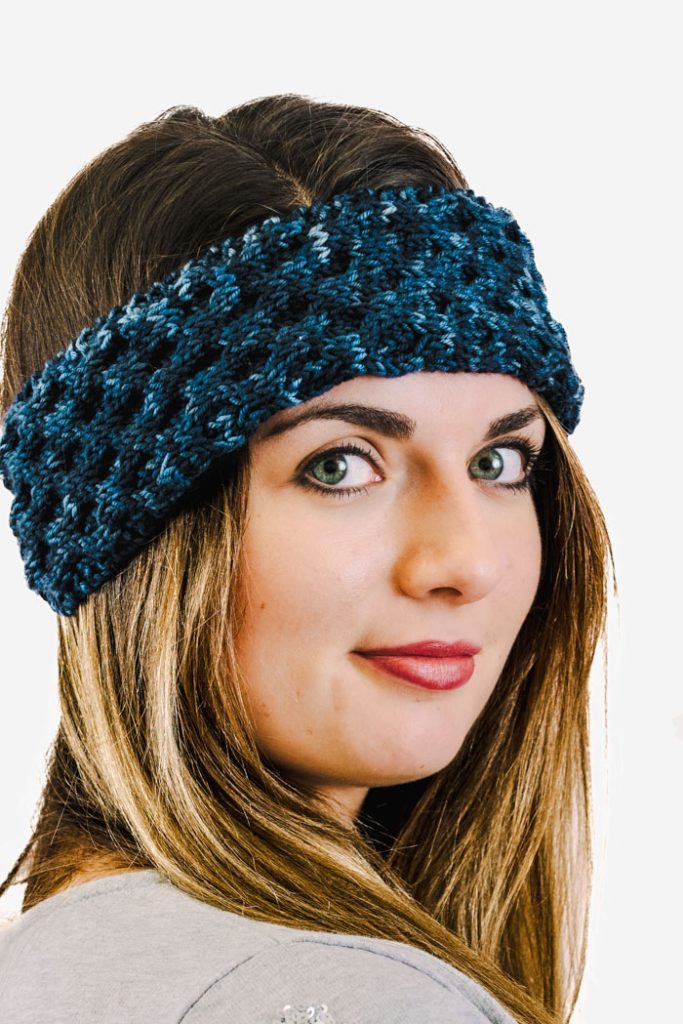
Keep your ears toasty and your look effortlessly chic with the Honeycomb Headband. Designed for active days or casual outings, this high-coverage headband features a textured honeycomb cable pattern that adds visual interest and a snug fit. The use of a provisional cast-on and a Kitchener stitch join ensures a completely seamless finish, so there’s no irritation at the back of your neck. Whether you’re hitting the trails, running errands, or just battling a chilly breeze, this headband offers the perfect blend of comfort, function, and style.
Skill Level: Intermediate
Size: Finished Size 3.5” / [8.8 cm] wide x 18 (20, 22)” / [43 (50, 55) cm] total length to fit Youth, Adult and Large Adult Head.
2” / [5 cm] of negative ease recommended.
Shown in size Adult.
Gauge: 32 sts and 32 rows = 4” [10 cm] in Honeycomb Cable Stitch after wet blocking
Materials
 Yarn: One Room Fibers Merino DK (100% Superwash Merino; 231 yards [211 meters]/100 grams): Minnesota Blue, 1 balls
Yarn: One Room Fibers Merino DK (100% Superwash Merino; 231 yards [211 meters]/100 grams): Minnesota Blue, 1 balls
Needles: US size 6 (4 mm): straight or 24” circular
Notions: US size G/6 (4 mm) crochet hook; smooth scrap yarn in contrasting color for provisional cast-on; cable needle; two stitch markers; tapestry needle
Special Stitches
Crochet Chain
Place a slip knot on your hook and grab working yarn with the hook and pull through the slip knot. This makes one chain. Repeat to desired length.
Provisional Cast-On
Using your scrap yarn, crochet a single chain that is 16 chains long. Leave a long tail and cut yarn. Turn the chain upside down and look for bumps that look like purl stitches. Being sure to leave a long tail, *pick up a stitch by inserting your needle into the bumps and pulling yarn through; repeat from until 12 stitches are on your needle. When ready to expose live stitches, unravel the last crochet chain worked and pull on the yarn. Pick up stitches with your knitting needle.
Kitchener Stitch
Hold the 2 needles holding the live stitches parallel. Thread your long tail onto a tapestry needle.
Set-up: Beginning with the first stitch on the needle behind the one closest to you, slide the needle through the stitch as if to purl. Leave stitch on needle. Now slide your tapestry needle through the first stitch as if to knit. Leave stitch on needle.
*Slide tapestry needle through first stitch on back needle as if to purl, slide stitch off knitting needle, then slide tapestry needle through next stitch on back needle as if to knit, leave stitch on needle. Slide tapestry needle through first stitch on front needle as if to knit, slide stitch off knitting needle, then slide tapestry needle through next stitch on front needle as if to purl, leaving stitch on needle; repeat from * until all stitches are used.
Honeycomb Cable
Row 1 and all odd numbered rows (WS): K2, p to last 2 sts, k2.
Row 2: K2, *2/2 RC, 2/2 LC. Repeat from * to end of the row, K2.
Row 4: Knit
Row 6: K2, *2/2 LC, 2/2 RC. Repeat from to * the end of the row, K2.
Row 8: Knit
Rep Rows 1-8 for pattern.
2/2 RC: Sl 2 sts onto cable needle and hold to back of work, k2, k2 from the cable needle.
2/2 LC: Sl 2 sts onto cable needle and hold to front of work, k2, k2 from the cable needle.
Pattern
Using provisional cast-on, CO 12 sts.
Rnd 1 (RS): K2, pm, k8, pm, k2.
Note: The stitch markers mark the center Honeycomb Cable pattern.
Rnd 2 (WS): K2, p8, k2.
Rnd 3: K2, 2/2 RC, 2/2 LC, k2.
Rnd 4: K2, p8, k2.
Rnd 5: K12.
Rnd 6: K2, p8, k2.
Rnd 7: K2, 2/2 LC, 2/2 RC, k2.
Rnd 8: K2, p8, k2.
Rnd 9: K2, (M1R, k1) twice, k5, (M1L, k1) twice, k1 – 4 sts inc’d; 16 sts.
Rnd 10: K2, p12, k2.
Rnd 11: K2, (M1R, k1) twice, 2/2 RC, 2/2 LC, (M1L, k1) twice, k2 – 4 sts inc’d; 20 sts.
Rnd 12: K2, p16, k2.
Rnd 13: K1, (k1, M1R) twice, k14, (M1L, k1) twice, k1 – 4 sts inc’d; 24 sts.
Rnd 14: K2, p11, (p4, k1) twice, k1.
Rnd 15: K2, (M1R, k1) twice, k4, 2/2 LC, 2/2 RC, k5, (M1L, k1) twice, k1 – 4 sts inc’d; 28 sts.
Rnd 16: K2, p24, k2.
Rnd 17: K28.
Rnd 18: K2, p24, k2.
Rnd 19: K2, (2/2 RC, 2/2 LC) 3 times, k2.
Rnd 20: K2, p24, k2.
Rnd 21: K28.
Rnd 22: K2, p24, k2.
Rnd 23: K2, (2/2 LC, 2/2 RC) 3 times, k2.
Rnd 24: K2, p24, k2.
Rnd 25: K28.
Rep Rnds 18-25 until Headband meas 15 (17, 19)” / [38 (40, 50) cm]
Rnd 26: K2, p24, k2.
Rnd 27: K2, (2/2 RC, 2/2 LC) 3 times, k2.
Rnd 28: K2, p24, k2.
Rnd 29: K28.
Rnd 30: K2, p24, k2.
Rnd 31: K2, sssk, k1, (2/2 RC, 2/2 LC) twice, k1, k3tog, k2 – 4 sts dec’d; 24 sts
Rnd 32: K2, p20, k2.
Rnd 33: K2, sssk, k14, k3tog, k2 – 4 sts dec’d; 20 sts.
Rnd 34: K2, p16, k2.
Rnd 35: K2, sssk, k1, 2/2 RC, 2/2 LC, k1, k3tog, k2 – 4 sts dec’d; 16 sts.
Rnd 36: K1, p13, k2.
Rnd 37: K2, ssk, k8, k2tog, k2 – 2 sts dec’d; 14 sts.
Rnd 38: K2, p10, k2.
Rnd 39: K1, ssk, 2/2 LC, 2/2 RC, k2tog, k1 – 2 sts dec’d; 12 sts.
Rnd 40: K2, p8, k2.
Rnd 41: K12.
Rnd 42: K2, p8, k2.
Rnd 43: K2, 2/2 RC, 2/2 LC, k2.
Rnd 44: K2, p8, k2.
Rnd 45: K12.
Rnd 46: K2, p8, k2.
Rnd 47: K2, 2/2 LC, 2/2 RC, k2.
Rnd 48: K2, p8, k2.
Do not bind off. Break yarn leave a long tail for seaming in Kitchener Stitch.
Finishing
Unravel provisional cast-on and pick up live sts. Align the two ends of the headband and join through Kitchener Stitch (see Special Stitches).
Weave in all end. Block as needed.


Nice Pattern I worked mine in worsted weight and turned out beautifully!